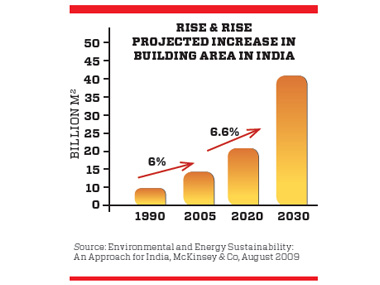Let us ask you a question. Who made the bricks your home or office was built with? Canyou remember the name of the maker? No? Can you remember the name of any brick-maker?We thought not. Our bet is that the moment we said ‘brick-maker,’ you thought of all those brick kilns spread across rural India you saw on your road and rail trips. And truth be told, you are not far off in your assumption that these are indeed India’s brick-makers.
Brick-making is one of the most unorganized sectors in India. Every year, India produces over 200 billion bricks from 100,000 brick kilns. This kiln-dominated industry is also, according to the United Nations Environment Program, the biggest industrial consumer of coal in India-over 25 million tons of coal per year. To be clear, brick-making alsodoes not have any similarity to the steel or cement industry, where there is a clearstructure with dominant players.
Sourabh Bansal, a graduate from IIT Kharagpur, was one of those who had identified these markers when he was looking for a business idea right after his graduation in the year 2007. “I wanted to look at creating efficiencies across environment, labor and supply chain in the building materials space,” says Bansal.
“In that space, the bricks industry had the most number of these inefficiencies,” he says. Having seen what India’s brick-makers were doing, Bansal looked at processes being used in other parts of the world. Here, he found out about Autoclaved Aerated Concrete blocks(AAC blocks). An alternative to clay bricks, these bricks were first developed back in the 1920s in Sweden.
An AAC block, Bansal says, can be 70 percent lighter and up to nine to ten times bigger than a clay brick. They are also well known for their thermal insulation properties. “These blocks are porous in nature. There is a honey comb-like structure inside the block. This is responsible for its light weight and the thermal insulation it provides,” Bansal explains.
While these bricks were being manufactured in India, Bansal found that they were primarily being used for high-cost niche projects.
A brick for all
Bansal set up Magicrete in 2008 to correct that paradigm. In June that year, Magicrete began commercial production of AAC blocks after he was joined by Puneet Mittal, a chartered accountant, and co-founder of Magicrete along with Bansal’s brother Sidharth, a graduatefrom IIT Delhi and IIM Lucknow.
Bansal knew his play here. He was well aware that he wasn’t bringing a brand new innovation into the market. Equally, he knew that AAC blocks could disrupt the brick industry if he could build and run his business right.
The team at Magicrete had identified the three factories that produced AAC blocks in India in 2009 and figured that with their capacity, they would only be able to supply the product for niche projects or specific needs. Like when a 10-storey building wants to add anotherfloor without too much extra weight.
[caption id=“attachment_81805” align=“alignleft” width=“380”]  Image; Entrepreneur India[/caption]
The company therefore focused on innovating to enable the mass adoption of AAC blocks in India’s construction industry. For that, Bansal had to fix one major challenge - price, which was marginally higher than clay bricks. The effort therefore was to make people seethat this marginally higher priced product also came with significant advantages and helped save on other costs like cooling solutions.
Bansal takes us through the basics of building and tells us that one cubic meter of construction requires 600 bricks. In 2009, he says, the cost to a customer for this was Rs 2,000, which has now gone up to Rs 3,000 owing to the increase in labor and fuel costs.
AAC blocks on the other hand, he says, cost Rs 3,500 per cubic meter in 2009 and that figure has not gone up significantly since. “Labor and fuel account for only 15 percent of the cost for an AAC block,” he says, adding that the cost of lime and cement affects the cost of these blocks much more than labor and fuel.
A building on an average, Bansal estimates, needs about 750 cubic meters of the product or about 50,000 blocks.
Mumbai based architect Vivek Popli says that construction using AAC blocks is also much quicker. “The blocks enable much more efficiency in the construction process,” he says.
North by West
Magicrete now has over 1000 customers and has sold 50 million AAC blocks to date. Its customers include the builders of the Sofitel Hotel and the Indiabulls Finance Centre in Mumbai.
Set up with a startup capital of Rs 25 crore, Magicrete touched a turnover of Rs 100 crore in FY13 and aims to touch Rs 500 crore by the year 2017. Besides AAC blocks, Magicrete has also expanded into manufacturing other products like Magicplast, a plastering product.
Early last year, the company raised Rs 35 crore from Motilal Oswal Private Equity Advisors. Prakash Bagla, Principal at Motilal Oswal, says that while Magicrete has been growing fastin one part of India, it has to replicate its success in other regions.
Bansal says that since his first manufacturing facility was in Surat, most of his current customers are from Western India. But the launch of a new plant in Haryana this year has opened up the booming north Indian construction market for the company. The two plantstogether have a manufacturing capacity of 760,000 cubic meters. More plants, we are told, are on the anvil.
Bagla says as the company goes into its next phase of growth, it will need a robust organizational setup. Agreeing with that, Bansal tells us that the company has beengrowing very rapidly. Managing the bandwidth and ensuring team productivity have been a major challenge for him.
His next investment, therefore, would be in the building blocks of his business.
This article first appeared in Entrepreneur India magazine.


)
)
)
)
)
)
)
)
)



